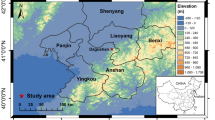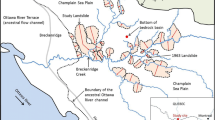Abstract
In 1988 a major landslide which required the evacuation of more than 50 families occurred in the little town of Nanka in Anambra State, Nigeria.
Investigation revealed that the landslides were caused by an overconsolidated, very highly plastic mudstone layer (PI=67) which probably contained quantities of montmorillonite clay. Peak strength values of remolded samples of the mudstone measured in the ordinary shear box test differed from those of non-remolded (intact) samples only in showing zero cohesion. These values probably represent the strength of the mudstone in its normally consolidated condition.
Stability analysis indicated that the major slide approximated more to a sliding block than to a circular failure with the mudstone layer as the base. It also showed that the peak strength at which the major slide occurred probably represents the strength of the mudstone in its fully softened or critical state, while the residual strength at which the minor slides occurred probably represents the strength at large displacements when perhaps the clay particles had become highly oriented in the direction of movement.
In the present study, for the first time, the landslides in the highly unstable Nanka area are explained by the presence of active clays.
Résumé
En 1988 a eu lieu un glissement de terrain catastrophique qui a nécessité l'évacuation de plus de 50 familles dans la petite ville de Nanka dans l'état d'Anambra au Nigeria.
D'après les renseignements obtenus le glissement fut causé par une couche d'argilite très plastique (IP=67) et surconsolidée, cette couche pouvant contenir des quantités importantes de montmorillonite. Les valeurs de résistance les plus élevées atteintes par les échantillons remaniés mesurées à la boite de cisaillement n'ont montré comme différence avec les échantillons non remaniés (intacts), qu'une cohésion nulle. Ces valeurs indiquent probablement la résistance de l'argilite dans sa condition de consolidation normale.
L'analyse de stabilité a indiqué que le glissement majeur s'approchait plus d'un bloc glissé que d'une rupture circulaire avec la couche d'argilite comme base. Cela a aussi montré que la résistance la plus élevée liée au glissement majeur représente probablement la résistance de l'argilite dans son état critique tandis que les résistances résiduelles qui ont correspondu aux glissements mineurs représentent probablement la résistance après de grands déplacements quand les particules argileuses s'étaient peut-être orientées dans la direction du mouvement.
Dans cette étude c'est la première fois que des glissements de terrain dans la région très instable de Nanka sont expliqués par la présence d'argiles actives.
Similar content being viewed by others
References
AKUJIEZE, C.N. 1984: The hydrogeology of the area (Nanka Sand) south of the upper sector of the Idemili drainage basin. M.Sc. thesis, University of Nigeria, Nsukka.
Australian Standard As 1289: C8.1-1980. Methods of testing soils for engineering purposes, part C-Soil classification tests: Determination of Emerson class Number of a soil.
EARLY, K.R. and SKEMPTON, A.W. 1972: Investigations of the landslide at Walton's Wood, Staffordshire, Quart. Jour. Engng. Geol. 5: 19–41.
EGBOKA, B.C.E. and OKPOKO, E.I. 1985: Gully erosion in the Agulu-Nanka region of Anambra State, Nigeria. In (ed), Challenges in African hydrology and water resources, (Proc. Harare Symposium) IAHS Publ. 144: 335–347.
EGBOKA, B.C.E. and NWANKWOR, G.I. 1985: The hydrogeological and geotechnical parameters as causative agents in the generation of erosion in the rain forest belt of Nigeria. Jour. African Earth Sci. 3(4) 417–425.
EZECHI, J.I. 1987: An engineering geological study of selected gully sites in eastern Nigeria. M.Sc. thesis, University of Nigeria, Nsukka.
FLOYD, B. 1965: Soil erosion and deterioration in eastern Nigeria. The Nigerian Geogr. Jour. 8(1): 33–44.
GROVE, A.T. 1956: Soil erosion in Nigeria. In: Steel, R.W. and Fisher, C.A. (eds.), Geographical essays on British tropical lands. George Philip & Sons Ltd. London pp. 99–111.
LADD, C.C. and LAMBE, T.W. 1961: The identification and behaviour of compacted expansive clays. Proc. 5th Int. Conf. Soil Mech. Of Found. Engng., Paris, 1: 201–205.
NWAJIDE, C.S. 1977: The stratigraphy and sedimentology of the Nanka Sand. M. Phil thesis, University of Nigeria, Nsukka.
NWAJIDE, C.S. and HOGUE, M. 1979: Gullying processes in southeastern Nigeria. The Nigerian Field, 44(2): 64–74.
OFOMATA, G.E.K. 1965: Factors of soil erosion in the Enugu area of Nigeria. The Nigerian Geogr. Jour. 8(1): 45–59.
OGBUKAGU, I.K.N. 1976: Soil erosion in the northern parts of the Awka-Orlu Uplands, Nigeria. Nigerian Jour. Mining and Geol. 13: 6–19.
OGBUKAGU, IK.N. 1985: A general survey of the economic potentialities of clays and shales of southeastern Nigeria. Jour. Indian Academy of Sciences.
OKAGBUE, C.O. 1986: Gully development and advance in a rain forest of Nigeria. Proc. 5th Congress, Int. Assoc. Engng. Geol. Buenos Aires, pp. 1999–2010.
OKAGBUE, C.O. and EZECHI, J.I. 1988: Geotechnical characteristics of soils susceptible to severe gullying in eastern Nigeria. Bull. Int. Assoc. Eng. Geol. 38: 111–119.
OLA, S.A. 1981: Mineralogical properties of some Nigerian residual soils in relation with building problems. Engng. Geol. 15: 1–13.
POPESCU, M.E. 1980: Engineering problems associated with expansive clays from Romania. Engng. Geol. 14: 43–53.
SKEMPTON, A.W. 1953: The colloidal “activity” of clays. Proc. 3rd Int. Conf. Soil Mech (Zurich), 1: 57–61.
SKEMPTON, A.W. 1954: A foundation failure due to clay shrinkage caused by poplar trees. Proc. Inst Civil Engr., 3: 66–85.
SKEMPTON, A.W. 1964: The long term stability of clay slopes. Geotechnique, 14: 77–101.
Author information
Authors and Affiliations
Rights and permissions
About this article
Cite this article
Okagbue, C.O. The 1988 Nanka landslide, Anambra state, Nigeria. Bulletin of the International Association of Engineering Geology 46, 79–87 (1992). https://doi.org/10.1007/BF02595037
Published:
Issue Date:
DOI: https://doi.org/10.1007/BF02595037




